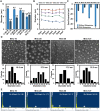Kinetically inert manganese (II)-based hybrid micellar complexes for magnetic resonance imaging of lymph node metastasis
- PMID: 37293571
- PMCID: PMC10244211
- DOI: 10.1093/rb/rbad053
Kinetically inert manganese (II)-based hybrid micellar complexes for magnetic resonance imaging of lymph node metastasis
Abstract
The localization and differential diagnosis of the sentinel lymph nodes (SLNs) are particularly important for tumor staging, surgical planning and prognosis. In this work, kinetically inert manganese (II)-based hybrid micellar complexes (MnCs) for magnetic resonance imaging (MRI) were developed using an amphiphilic manganese-based chelate (C18-PhDTA-Mn) with reliable kinetic stability and self-assembled with a series of amphiphilic PEG-C18 polymers of different molecular weights (C18En, n = 10, 20, 50). Among them, the probes composed by 1:10 mass ratio of manganese chelate/C18En had slightly different hydrodynamic particle sizes with similar surface charges as well as considerable relaxivities (∼13 mM-1 s-1 at 1.5 T). In vivo lymph node imaging in mice revealed that the MnC MnC-20 formed by C18E20 with C18-PhDTA-Mn at a hydrodynamic particle size of 5.5 nm had significant signal intensity brightening effect and shortened T1 relaxation time. At an imaging probe dosage of 125 μg Mn/kg, lymph nodes still had significant signal enhancement in 2 h, while there is no obvious signal intensity alteration in non-lymphoid regions. In 4T1 tumor metastatic mice model, SLNs showed less signal enhancement and smaller T1 relaxation time variation at 30 min post-injection, when compared with normal lymph nodes. This was favorable to differentiate normal lymph nodes from SLN under a 3.0-T clinical MRI scanner. In conclusion, the strategy of developing manganese-based MR nanoprobes was useful in lymph node imaging.
Keywords: T1 contrast agent; amphiphilic manganese chelate; kinetically inert; magnetic resonance imaging; sentinel lymph node.
© The Author(s) 2023. Published by Oxford University Press.
Figures








Similar articles
-
Manganese porphyrin/ICG nanoparticles as magnetic resonance/fluorescent dual-mode probes for imaging of sentinel lymph node metastasis.J Mater Chem B. 2022 Dec 14;10(48):10065-10074. doi: 10.1039/d2tb01885c. J Mater Chem B. 2022. PMID: 36454208
-
Lymph Node Metastases Detection Using Gd2O3@PCD as Novel Multifunctional Contrast Imaging Agent in Metabolic Magnetic Resonance Molecular Imaging.Contrast Media Mol Imaging. 2022 Oct 12;2022:5425851. doi: 10.1155/2022/5425851. eCollection 2022. Contrast Media Mol Imaging. 2022. PMID: 36304774 Free PMC article.
-
Relaxivity Enhancement of Hybrid Micelles via Modulation of Water Coordination Numbers for Magnetic Resonance Lymphography.Nano Lett. 2023 Sep 27;23(18):8505-8514. doi: 10.1021/acs.nanolett.3c02214. Epub 2023 Sep 11. Nano Lett. 2023. PMID: 37695636
-
The clinical value of hybrid sentinel lymphoscintigraphy to predict metastatic sentinel lymph nodes in breast cancer.Nucl Med Mol Imaging. 2015 Mar;49(1):26-32. doi: 10.1007/s13139-014-0298-9. Epub 2014 Oct 17. Nucl Med Mol Imaging. 2015. PMID: 25774235 Free PMC article.
-
How Pre-operative Sentinel Lymph Node Contrast-Enhanced Ultrasound Helps Intra-operative Sentinel Lymph Node Biopsy in Breast Cancer: Initial Experience.Ultrasound Med Biol. 2019 Aug;45(8):1865-1873. doi: 10.1016/j.ultrasmedbio.2019.04.006. Epub 2019 May 14. Ultrasound Med Biol. 2019. PMID: 31101445 Review.
Cited by
-
Artificial intelligence-assisted magnetic resonance lymphography for evaluation of micro- and macro-sentinel lymph node metastasis in breast cancer.Mater Today Bio. 2025 Mar 22;32:101692. doi: 10.1016/j.mtbio.2025.101692. eCollection 2025 Jun. Mater Today Bio. 2025. PMID: 40225140 Free PMC article.
-
Nanomaterial-assisted pancreatic cancer theranostics.Regen Biomater. 2025 Jun 11;12:rbaf054. doi: 10.1093/rb/rbaf054. eCollection 2025. Regen Biomater. 2025. PMID: 40585530 Free PMC article. Review.
-
Mn-Based MRI Contrast Agents: An Overview.Molecules. 2023 Oct 26;28(21):7275. doi: 10.3390/molecules28217275. Molecules. 2023. PMID: 37959694 Free PMC article. Review.
References
-
- Fujimoto Y, Okuhata Y, Tyngi S, Namba Y, Oku N.. Magnetic resonance lymphography of profundus lymph nodes with liposomal gadolinium-diethylenetriamine pentaacetic acid. Biol Pharm Bull 2000;23:97–100. - PubMed
-
- Schütz G, Lohrke J, Pietsch H.. Lymph node staging using dedicated magnetic resonance contrast agents—the accumulation mechanism revisited. Wiley Interdiscip Rev Nanomed Nanobiotechnol 2015;7:238–49. - PubMed
-
- Lu B, Wang H, Lu Q, Tang Z, Dou H, Dai T, Li S.. Novel hybrid dextran-gadolinium nanoparticles as high-relaxivity T1 magnetic resonance imaging contrast agent for mapping the sentinel lymph node. J Comput Assist Tomogr 2019;43:350–7. - PubMed
-
- Fu X, Fu S, Cai Z, Jin R, Xia C, Lui S, Song B, Gong Q, Ai H.. Manganese porphyrin/ICG nanoparticles as magnetic resonance/fluorescent dual-mode probes for imaging of sentinel lymph node metastasis. J Mater Chem B 2022;10:10065–74. - PubMed
-
- Han M, Kang R, Zhang C.. Lymph node mapping for tumor micrometastasis. ACS Biomater Sci Eng 2022;8:2307–20. - PubMed
LinkOut - more resources
Full Text Sources

